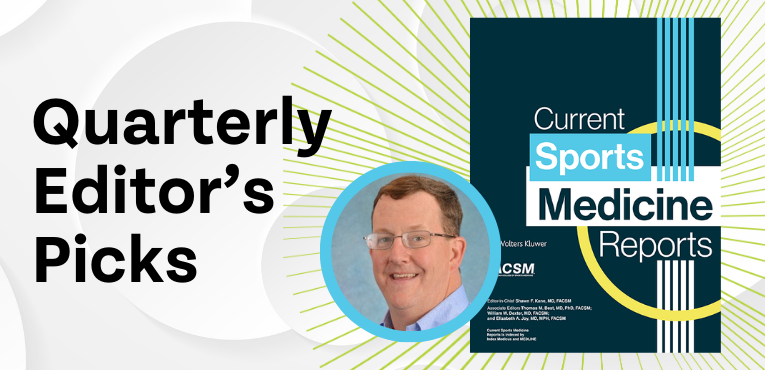Shawn F. Kane, MD, FACSM |
Oct.
15, 2024
 Welcome to the highlights and the review of the AWESOME material published over the last quarter in Current Sports Medicine Reports (CSMR). I’m going to do something a little different this quarter and highlight a couple invited commentaries, along with interesting case reports and section articles.
Welcome to the highlights and the review of the AWESOME material published over the last quarter in Current Sports Medicine Reports (CSMR). I’m going to do something a little different this quarter and highlight a couple invited commentaries, along with interesting case reports and section articles.
Invited Commentaries
The Cannabis Shift: How We Educate and Message is Key submitted by Jeff Konin, PhD, ATC, PT, FACSM. The times are changing, and our athletes deserve better from us is the message from Dr. Konin in this commentary. This invited commentary lays out an effective framework for how those caring for athletes need to frame and deliver the message. I was unable to attend but Dr. Konin spoke to our athletes here at the University of North Carolina-Chapel Hill and I can report that across the board from athletes to coaches to administrators his message was well received.
You can also read a blog post from Dr. Konin on his article here.
Transgender Athlete Participation in Sport: Misplaced Fear and the Harms of Exclusion submitted by Robert S. Phillips, PT, DPT, PhD; Lee R. Ryder, PT, DPT and Ebony Jackson Clark, PT, DPT. The last thing we need to do in this country and across the world is put up more barriers to physical activity, sport participation and inclusion. It is common knowledge that physical activity is good, no it’s great for a person’s health and well-being and it has a positive impact on multiple aspects of patients’ lives. The same is true for sports participation on a team or as an individual. There is no reason to demonize, add to the exclusion and isolation of any subset of our population. The authors’ message comes from the viewpoint of physical therapists and translates across all medical specialties.
Case Reports
Case reports are a great way to learn whether the write-up is about some rare, uncommon condition or just a different presentation of a common problem. I would like to highlight two not-to-be-missed cases from the past quarter:
Hip Pain…Is It All in Your Head? submitted by Lammlein and Creech-Organ. This is very interesting case that highlights the need for a broad differential to help determine the true etiology of the problem and not just focus on the chief complaint. This is an interesting case of a 40-year-old women with a couple of chronic medical issues who was found to have bilateral avascular necrosis of the femoral head. After the second joint replacement, the patient developed premature ovarian failure and endocrinology work up revealed a pituitary microadenoma. Upon resection a couple of her chronic medical issues resolved. It makes me wonder, if the hip replacements, at least the second one, could have been avoided.
Exertional Compartment Syndrome in a Volleyball Player with Structural Abnormalities: A Case Report submitted by Wilson, Oca, Meller, Allen, and Strauss. Exertional compartment syndrome is a great example of one of those conditions that you should have in your differential diagnosis for exertional lower extremity pain. While it can be easy to diagnose based on pressure testing, the treatment can be challenging, and surgery is not a guarantee. This case highlights the importance of follow up, developing a plan, revising the plan based on what happens and, when the time is right, definitively treating.
Articles
We also have some awesome articles that cover a variety of areas, and I would like to highlight three from the past quarter:
Vigorous Exercise in Patients with Hypertrophic Cardiomyopathy submitted by Fox, Fox, Jacobsen, Blumenthal, and Barouch. I found this article so interesting as it changes the narrative around hypertrophic cardiomyopathy (HCM), a condition that impacts 1 in 200 to 500 patients. Speaking for myself, HCM has always been thought of as the cause of sudden cardiac death, a murmur that we all got asked about over and over but rarely heard about, not a condition that was managed in patients. The timing of this article was fortuitous as I now have HCM patients on my panel. The authors do a great job laying out an active management plan for HCM patients.
Managing Pediatric Hip Pain Patients with Precision submitted by Knobloch, Kim, Babo, McCall and Covey. Pediatric hip pain can be incredibly challenging, and the differential includes infectious, metabolic and traumatic etiologies. This article is excellent, well-written and thorough and can help with the proper diagnosis and work up of a pediatric patient with hip pain. If you are involved in medical education, I would recommend using this article when teaching about the pediatric hip.
Contemporary Issue: Health and Safety of Female Wrestlers submitted by Jagim, Moschelli, Woodroffe, Horswill, and Bloomfield. The sport of female wrestling is growing exponentially. This paper goes into the many challenges of keeping female wrestlers healthy. Determining the minimal wrestling weight and having a safe and effective plan to get there is essential for the health and safety of the wrestlers.
CSMR is ACSM’s official monthly clinical-review e-journal. Written specifically for physician and clinician members, CSMR articles provide thorough overviews of the most current sports medicine literature. ACSM physician members receive an online subscription to this journal as a member benefit.
 Shawn F. Kane, MD, FACSM is a family physician, professor in the Department of Family Medicine, and adjunct assistant professor in the Department of Exercise and Sports Science at the University of North Carolina (UNC) Chapel Hill. He received his medical degree from the Uniformed Services University of the Health Sciences and served in the U.S. Army for 27 years. While in the Army he spent more than 18 years serving as a physician-leader in numerous units within the US Army Special Operations Command. He is interested in sports medicine, concussion care, veterans’ health, and primary care of patients with post-traumatic stress disorder. Dr. Kane joined ACSM in 2003 and became a fellow in 2011. He currently serves as the editor-in-chief for Current Sports Medicine Reports, on ACSM’s Clinical Sports Medicine Leadership Committee, ACSM’s Health & Fitness Summit Program Committee, and ACSM’s Program Committee. Outside of the office, Dr. Kane enjoys hanging out with his Leonbergers (big, furry, cute German Mountain dogs), as well as working out and traveling.
Shawn F. Kane, MD, FACSM is a family physician, professor in the Department of Family Medicine, and adjunct assistant professor in the Department of Exercise and Sports Science at the University of North Carolina (UNC) Chapel Hill. He received his medical degree from the Uniformed Services University of the Health Sciences and served in the U.S. Army for 27 years. While in the Army he spent more than 18 years serving as a physician-leader in numerous units within the US Army Special Operations Command. He is interested in sports medicine, concussion care, veterans’ health, and primary care of patients with post-traumatic stress disorder. Dr. Kane joined ACSM in 2003 and became a fellow in 2011. He currently serves as the editor-in-chief for Current Sports Medicine Reports, on ACSM’s Clinical Sports Medicine Leadership Committee, ACSM’s Health & Fitness Summit Program Committee, and ACSM’s Program Committee. Outside of the office, Dr. Kane enjoys hanging out with his Leonbergers (big, furry, cute German Mountain dogs), as well as working out and traveling.